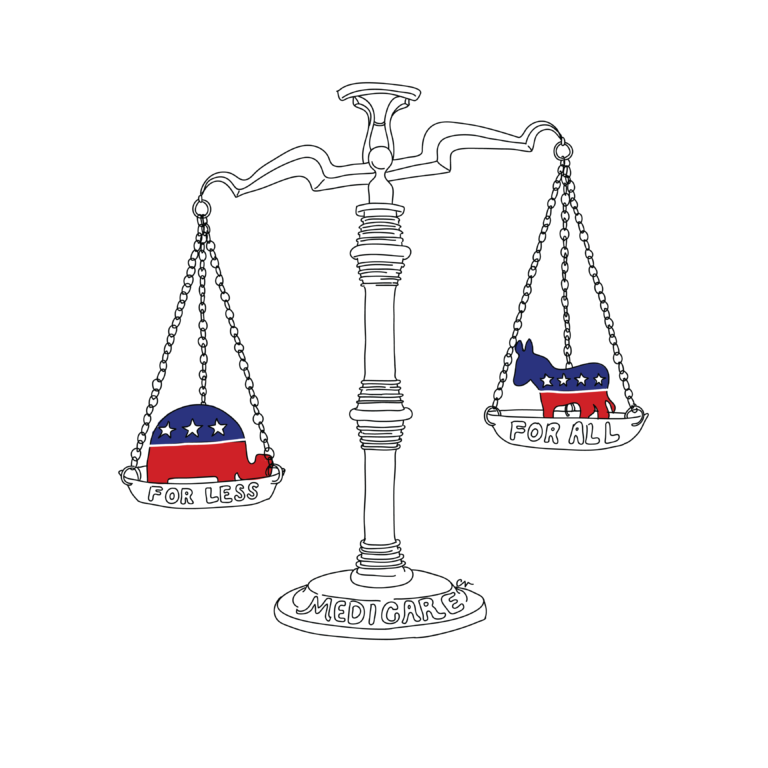
The 2024 election of Donald Trump shocked many across the United States. To a portion of the population, such an overtly right-wing and proto-fascist candidate gaining such prominence and winning the presidential election was unprecedented. But the win of the far-right in the U.S. was not a special case. This past election cycle for many European countries saw far-right parties make phenomenal gains in seats, with the European Parliament saw a massive swing to the right this past summer. In individual countries, the most notable right-wing successes included the victory of Marine Le Pen’s National Rally against Emmanuel Macron’s Renaissance party in France, along with shifts to the right in German and Austrian governments. This rise to power of the far-right in America is no outlier. Rather, it reflects a larger trend from its contemporaries in the Western world.
This far-right wave did not simply materialize out of nothing. It stems from extreme realities — or at least extreme perceptions of realities. The far-right has taken advantage of a burgeoning fear-mongering populism that has come to grip the Western world in recent years, with immigration and nationalism becoming the biggest hotbed issues through which they acquired support and power. With more immigrants flowing into Western countries from the Middle East, Africa, and Latin America (primarily in the case of the United States) due to conflicts, economic crises, and the prospect of better opportunities, the Western far-right parties utilized divisive language to take advantage of fears of losing national identity.
In Europe, many of the political strategies of these far-right parties stem from the perversion of reality by playing on the existing attitudes of a given sect of the European population. A 2021 study of 20 European countries found that negative feelings for multiculturalism had a strong association with anti-immigration beliefs. European politicians benefited from this social mood by advocating against the assimilation of foreign cultures and populations into Europe. France stands as a stark example as Islamophobia at the governing level continues to grow. In 2012, French Interior Minister Claude Guéant stated that, “all cultures are not of equal value.” In 2020, the French government limited the right to homeschool to put more emphasis on teaching students about their citizenship, culture, and values.
French political parties have capitalized on these sentiments greatly. Specifically, the National Rally led by Le Pen utilized these attitudes as a means to achieve massive policy wins. In 2023, she and her party pressured Prime Minister Macron and his Renaissance Party into passing a bill heavily limiting access to benefits for recently-arrived immigrants. The National Rally has always latched on to the idea of nationalism based upon a shared, uniform national identity and the exclusion of immigrants. Though Le Pen has tried to break free from the idea that the party is virulently bigoted, she has remained loyal to its core nationalist tenets. The weaponization of immigration benefited her in the aforementioned electoral win in the European Parliamentary elections as well.
France’s neighbors have also walked down the same path in recent years. In Germany, the far-right AfD, or Alternative for Germany, won large swaths of the population in the September elections. This success indicated not only a massive victory for the party, but also a massive shift to the right of the German population compared to previous elections. AfD won much of its vote off the back of nationalism and anti-immigration rhetoric. Similarly, the Netherlands far-right Party for Freedom and its leader Geert Wilders have also taken power by the same proxies while Austria’s right-wing, anti-Islam, hard-on-immigration Freedom Party won the largest share of votes in its history.
While xenophobia and fear of cultural replacement and ethnic violence has won in the ballot box, reality does not vindicate it. From 2023 to 2024, irregular border crossings in the E.U. dropped by 36 percent. A study covering Germany from the years 2008 to 2019 found that a rise in refugees and immigrants has either a negative or insignificant effect on crime rates. Massive immigration has also alleviated serious labor shortages in the E.U. economy in recent years while the region has hit record lows in unemployment.
Unfortunately, distorted perceptions have triumphed over realities in recent political campaigns. The Trump campaign espoused such rhetoric to pervert perceptions of reality. On his road to victory, Trump made false claims that Haitian immigrants had eaten dogs and cats in Springfield, Ohio and that Latin American immigrants had taken over parts of Aurora, Colorado violently. Furthermore, the Trump campaign ran an alarmist political ad which claimed that “they’re coming by the thousands,” with erratic music and videos of immigrants and violence side-by-side. With the propagation of this inflammatory propaganda, it is no wonder that 45 percent of the American population believes that there is a crisis at the border, according to the Pew Research Center.
This strategy of anti-immigrant messaging which was rife with misinformation aided Trump in his massive electoral victory of Kamala Harris, who herself failed to take a concrete stance against the misinformation in the months leading up to the monumental election. The reality, however, proves Trump wrong like it does for his contemporaries in Europe. Along with the claims about Springfield and Aurora being entirely false, the fears of immigrants making the U.S. more dangerous has no grounds. All immigrants, including undocumented immigrants, commit crimes at a lower rate than native-born citizens. Furthermore, immigrants have generated massive amounts of economic prosperity by filling necessary job vacancies and paying large amounts of taxes. For example, undocumented immigrants pay $1 billion worth of taxes in Georgia alone, and one in six of all American tax dollars come from immigrants.
Despite the mass deviation from fact of far-right parties across the board in Western Europe and the U.S., many still won decisive electoral victories. Why did more left and centrist parties fail to make gains in many of these countries? The answer comes down to division among the left wing which in turn paralyzes the ability for setting concrete policy goals. Without these policy goals, voters have nothing to latch on to and will instead vote for clear messaging even if it doesn’t represent reality and comes with an alarming populist fanaticism.
Germany saw this happen this recent election cycle. Two of the far-left parties, Die Linke and the Bündnis Sahra Wagenknecht, both deviated immensely on numerous core issues such as immigration and experienced major losses in representation for Die Linke.
France witnessed a similar phenomenon that ended much differently. Realizing that the National Rally had made massive strides from the European Parliament elections and previous polling, the two primary center left parties — the Green and Socialist Party and far left parties, the Unbowed and Communist parties — formed an unlikely alliance despite years of division. The alliance then made clear policy goals such as lowering France’s retirement age, expanding social benefits, and increasing wages to drive voters to their side with promises of prosperity. This helped pave the road for them winning the most seats and keeping the far-right at bay.
The U.K. saw Europe’s left take another victory as the Labour Party controlled the Parliament. Though the details differ quite a bit from France, the British example echoes the left’s need to unite and create concise policy goals to drive voter turnout. The center-left Labour Party capitalized on the right-wing Conservative Party dysfunction and promoted messages of investing in business, increasing wages, and improving E.U. relations, while actually going against the grain of the anti-immigration sentiment by advocating to ease the asylum-seeking process for undocumented immigrants.
The Democratic Party in America failed to follow the example of their French and British counterparts. After Joe Biden dropped out of the race far too late, Democrats produced a candidate in Kamala Harris that had not received de facto vindication from the electorate through a primary, demonstrating the party’s lack of cohesion. Then, Democrats focused almost uniquely on abortion and Trump’s threats to democracy. Though these issues matter to voters to a certain extent, the party completely missed on attracting working class voters by refusing to give a convincing economic plan that spoke to their needs. Democrats also rejected the messaging of more left components of their party friends like Alexandria Ocasio-Cortez and Bernie Sanders, the latter of whom explicitly stated that the Democrats had abandoned the working class. As a result, they lost monumentally. The far right’s messaging about immigration took the American electorate by storm, because it gave them something to grasp, while the left refused to deliver anything meaningful.
Moving forward, the left across the Western world must rally and create united fronts that allow for a cohesive agenda and policies that speak to working class constituents. The left wing of France and the U.K. both stopped a far-right surge that swept Europe through this strategy. If the Democrats in America refuse to learn, they will face even more catastrophic losses in the future.
The Zeitgeist aims to publish ideas worth discussing. The views presented are solely those of the writer and do not necessarily reflect the views of the editorial board.



